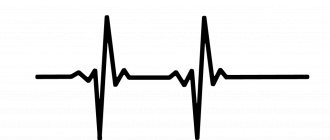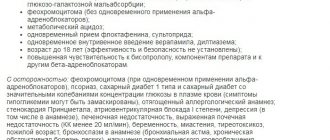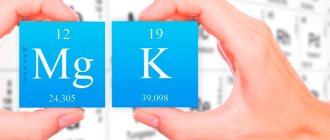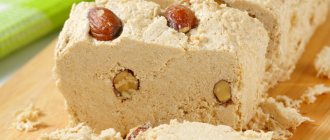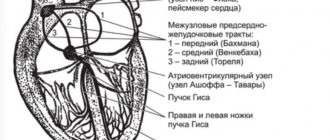Pharmacodynamics and pharmacokinetics
Bisoprolol is a selective β1-blocker and does not have intrinsic sympathomimetic or membrane-stabilizing activity.
Under the influence of low doses of the active substance bisoprolol fumarate in a patient:
- blood plasma (regulating blood pressure and water-salt homeostasis of the proteolytic enzyme) decreases
- myocardial oxygen demand decreases;
- the excitability and conductivity of the myocardium decreases;
- the frequency of contractions of the heart muscle decreases (both at rest and when under load);
- the formation of cyclic adenosine monophosphate from adenosine triphosphate, stimulated by catecholamines, decreases;
- the flow of calcium ions into the intracellular space decreases;
- cardiac output decreases (despite the fact that there is no significant decrease in stroke volume);
- atrioventricular (AV) conduction is inhibited;
- pressure decreases;
- symptoms of myocardial ischemia .
According to the abstract, Bisoprolol in a dosage significantly higher than the therapeutic one (0.2 g or more) can cause blockade, including β2-adrenergic receptors, mainly in the bronchi and smooth muscles of the vascular walls.
The drug is absorbed by approximately 80-90%, and the level of absorption does not depend on food intake. The concentration of the active substance in plasma reaches its maximum value 60-180 minutes after taking the tablet.
Bisoprolol fumarate is approximately 30% bound to plasma proteins. The substance has the ability to a small extent:
- pass through the placental and blood-brain barriers;
- penetrate into the milk of a nursing woman.
Approximately half of the dose taken is metabolized in the liver, resulting in the formation of inactive metabolites . The half-life varies from 10 to 12 hours. About 98% is eliminated from the body unchanged in the urine, up to 2% is excreted in bile.
Concor and alcohol
Drinking alcohol with Concor
It is known that when drinking alcohol, blood vessels dilate for a short time, that is, the heartbeat accelerates. True, after a short amount of time the opposite happens - vasospasm. And a sharp rise in blood pressure is not the most pleasant, but also not the most dangerous, thing that can await a patient taking Concor. The instructions directly state that Concor and alcohol are incompatible. The central nervous system is depressed, and the patient’s psychomotor abilities deteriorate. Also, do not forget that the medicine and alcohol will be excreted through one excretory system - the kidneys. This can lead to organ damage, and in some cases functional impairment may develop. Internal bleeding may begin, a hypertensive crisis, pulmonary edema, and vascular collapse may begin. But the worst result of taking Concor and alcohol together is death.
Therefore, doctors strongly recommend that you stop drinking alcohol while taking Concor.
Contraindications
The use of Bisoprolol is contraindicated in:
- hypersensitivity to the components of the drug;
- hypersensitivity to other β-blockers;
- acute heart failure (AHF);
- CHF in the stage of decompensation (if the patient requires inotropic therapy);
- shock (including cardiogenic shock);
- syndrome of weakness (dysfunction) of the sinus node;
- pulmonary edema;
- sinoatrial blockade;
- bradycardia (extremely low heart rate, in which the heart rate does not exceed 60 beats per minute);
- 2nd and 3rd degree AV block without pacemaker;
- severe form of arterial hypotension , in which the systolic blood pressure does not exceed 100 mm Hg. Art.);
- severe bronchial asthma
- noted in the history of COPD ;
- pheochromocytoma (in cases where the patient is not simultaneously prescribed α-blockers);
- poorly controlled diabetes mellitus ;
- metabolic acidosis;
- peripheral circulatory disorders in late stages (for example, with Raynaud's syndrome );
- refractory hypokalemia , hypercalcemia or hyponatremia ;
- hypolactasia;
- lactase deficiency;
- glucose-galactose malabsorption syndrome.
Due to the fact that there is not enough data on the safety and effectiveness of the drug for patients under 18 years of age, Bisoprolol is not used in pediatrics.
In addition, the drug is not prescribed to patients who are undergoing treatment with MAO inhibitors (with the exception of cases when the patient is prescribed B-type monoamine oxidase inhibitors).
Possibilities of bisoprolol in the treatment of cardiovascular diseases
In real clinical practice, beta-blockers (BABs) are one of the most widely used drugs in the treatment of cardiovascular diseases (CVD). The issues of choosing BAB still remain relevant.
As is known, beta-1-selective ABs are superior to non-selective ones: they significantly less increase peripheral vascular resistance, to a greater extent reduce the severity of the vasoconstrictor response to catecholamines and, therefore, are more effective in smokers, less likely to cause hypoglycemia in patients with diabetes mellitus (DM), less often cause withdrawal syndrome. Beta-1-selective ABs can be used in patients with obstructive pulmonary diseases; they change the lipid composition of the blood to a lesser extent.
One of the most highly cardioselective beta blockers is bisoprolol (Bidop). The affinity of bisoprolol for beta-1 adrenergic receptors is 75 times higher than for beta 2 adrenergic receptors. In a standard dose, the drug has almost no blocking effect on beta-2 adrenergic receptors and is therefore devoid of many undesirable effects. Bisoprolol in therapeutic dosages (2.5–10.0 mg/day) does not cause bronchospasm and does not impair respiratory function in people with chronic obstructive pulmonary disease (COPD). In addition, bisoprolol does not worsen renal function and intrarenal hemodynamics, does not affect carbohydrate metabolism and does not increase the content of cholesterol and lipoproteins in the blood plasma [1].
These properties determine the use of bisoprolol for various CVDs, primarily for arterial hypertension (AH) and coronary heart disease (CHD).
Benefits of bisoprolol for arterial hypertension
The main indications for the use of beta blockers in patients with hypertension are: coronary artery disease, a history of myocardial infarction, chronic heart failure (CHF), tachyarrhythmias, glaucoma [2].
In terms of antihypertensive activity, bisoprolol is not inferior to other beta blockers and is superior to them in a number of indicators. The double-blind randomized BISOMET trial showed that bisoprolol, like metoprolol, reduces blood pressure (BP) at rest, but is significantly superior to metoprolol in its effect on systolic blood pressure and heart rate (HR) during exercise [3]. The pronounced effectiveness of bisoprolol in patients leading an active lifestyle encourages the drug to be prescribed to younger patients with hypertension.
In this regard, we should recall the myths about the effect of beta-blockers on erectile function. Taking beta blockers is often associated with the possibility of sexual dysfunction. With regard to bisoprolol, the absence of a negative effect on sexual function in men has been convincingly proven. This property of bisoprolol increases adherence to treatment in young male patients who begin to suffer from hypertension in the active years of life. In a study by LM Prisant et al. demonstrated that the incidence of sexual dysfunction when taking bisoprolol did not differ from that when taking placebo [4].
When comparing bisoprolol with calcium antagonists (nifedipine) and angiotensin-converting enzyme inhibitors (ACEIs) (enalapril), it was found that it has no less antihypertensive activity. Moreover, in a comparative randomized study, bisoprolol (10–20 mg/day) led to a significant decrease in left ventricular myocardial mass index (LVMI) by 11%, which was identical to the effect of ACEI (enalapril, 20–40 mg/day) [5] .
Another study examined the effectiveness of bisoprolol in doses of 5–10 mg in patients with hypertension and left ventricular hypertrophy (LVH). After 6 months, the LVMM index significantly decreased by 14.6%, the myocardial thickness of the posterior wall of the left ventricle (LV) and interventricular septum by 8% and 9%, respectively, and the volume of cavities and LV ejection fraction did not change. At the same time, the regression of LV hypertrophy could not be explained by the hypotensive effect alone; in 5 patients who did not reach normal blood pressure values, a decrease in LVMM indices was also noted [6].
Assessment of organoprotective properties, including the effect of various antihypertensive drugs on arterial wall stiffness, is currently the subject of active study and debate. Taking into account the discovery of new markers of cardiovascular risk, we present data on the effect of bisoprolol on central pressure, pulse pressure and vascular wall stiffness. The stiffness of the vascular wall is one of the main factors determining pulse blood pressure. Both vascular wall stiffness and pulse pressure are highly correlated with endpoints such as cardiovascular mortality, myocardial infarction, and stroke. Central, or aortic, pulse pressure has an even closer relationship with cardiovascular risk [7].
Bisoprolol at a dose of 10 mg in patients with hypertension led to a significant decrease in pulse wave velocity, as well as an improvement in the elasticity of the brachial artery.
The ADLIB study examined the effects of different classes of antihypertensive drugs (amlodipine 5 mg, doxazosin 4 mg, lisinopril 10 mg, bisoprolol 5 mg and bendroflumethiazide 2.5 mg) on measures of vascular stiffness - central pressure, reflected wave and augmentation index. The most pronounced decrease in blood pressure in the brachial artery was caused by lisinopril and bisoprolol. Bisoprolol, along with lisinopril and amlodipine, reduced central blood pressure. At the same time, bisoprolol had the opposite effect on the augmentation index and reflected wave speed: the augmentation index was higher when using other drugs, and the reflected wave speed was maximum when treated with bisoprolol [8].
It is impossible not to dwell on aspects of the treatment of hypertension in obese patients. Hypertension is diagnosed in 88% of patients with abdominal obesity [9].
Despite the fact that beta blockers belong to the main class of drugs in the treatment of hypertension, obesity and metabolic syndrome are not the primary indication for their use, although the use of beta blockers in obese patients has a pathogenetic justification, given the key role of hyperactivity of the sympathetic nervous system in the development of hypertension in obesity.
The fear of prescribing beta blockers to a patient with metabolic syndrome is due to fears of worsening the course of diabetes. BAs have different prodiabetogenic potential. Thus, while taking bisoprolol and nebivolol in patients with hypertension and diabetes, there was no change in blood glucose levels, while treatment with atenolol led to a significant increase in its level. It was found that bisoprolol does not change blood glucose levels in patients with diabetes, and no dose adjustment of hypoglycemic agents is required, which indicates its metabolic neutrality [10].
Studies involving patients with diabetes, conducted with bisoprolol, have shown that, due to its high selectivity, the drug does not have a significant effect on carbohydrate and lipid metabolism and can be used in patients with diabetes.
A positive property of bisoprolol for use in obese patients with hypertension is its unique ability to dissolve in both fats and water (amphiphilicity). Due to its amphiphilic properties, bisoprolol undergoes 50% biotransformation in the liver, the rest is excreted unchanged by the kidneys. Considering the frequent presence of a “compromised” liver in patients with metabolic syndrome in the form of non-alcoholic fatty liver disease, the use of bisoprolol is justified for the treatment of hypertension in this category of patients. Amphiphilicity determines the balanced clearance of bisoprolol, which explains the low likelihood of its interaction with other drugs and greater safety when used in patients with moderate hepatic or renal insufficiency [11].
Polymorbidity and the presence of both COPD and CVD in one patient forces a careful approach to the choice of beta blockers. It has been established that the administration of beta blockers to patients with COPD who have suffered a myocardial infarction reduces the risk of mortality by 40% (compared to a similar group of patients without the use of beta blockers). According to S. Chatterjece, in patients with bronchial asthma, changes in bronchial patency when taking 10 and 20 mg of bisoprolol did not differ significantly from those after placebo [12].
The cardioselective beta blocker bisoprolol in patients with CVD and concomitant COPD does not have a negative effect on bronchial patency and improves the quality of life of patients, while the less selective atenolol and metoprolol worsened airway patency in this category of patients [13].
The use of bisoprolol in various forms of ischemic heart disease
Domestic recommendations for the diagnosis and treatment of coronary artery disease [14] consider beta blockers as first-line drugs for the treatment of various forms of coronary artery disease, including serving as a necessary component in the treatment of patients with a history of myocardial infarction and CHF. It is in these clinical situations that beta blockers can improve the prognosis of patients.
Antianginal properties make it possible to prescribe bisoprolol for the prevention of anginal attacks in patients with stable angina pectoris. The multicenter clinical trial TIBBS (Total Ischemic Burden Bisoprolol Study) demonstrated that bisoprolol effectively eliminates episodes of transient myocardial ischemia in patients with stable angina and increases heart rate variability [15]. This study also showed the effect of bisoprolol on improving the prognosis of coronary artery disease. It has been proven that the incidence of cardiovascular events during bisoprolol therapy is significantly lower than when taking nifedipine and placebo.
It was also found that the antianginal effectiveness of bisoprolol is comparable to atenolol, betaxolol, verapamil and amlodipine. Other studies have shown that bisoprolol is more effective in preventing the occurrence of anginal attacks and increases exercise tolerance to a greater extent than isosorbide dinitrate (used as monotherapy) and nifedipine. In patients with stable angina, bisoprolol can be used in combination with other antianginal agents (in particular, nitrates and calcium antagonists).
It was found that bisoprolol significantly reduces the risk of myocardial infarction and mortality from CVD in patients who underwent surgery on the great arteries. As a means of secondary prevention of myocardial infarction, the use of bisoprolol in stable patients who have suffered a myocardial infarction (starting from 5–7 days of the disease) is justified [16].
Choosing bisoprolol
Considering the wide range of medicines on the Russian market and the need for an adequate choice, the problem of interchangeability of original drugs with generics for economic reasons is very relevant. The main limitation in the widespread use of original medicines is their high cost. On the other hand, the fact that the original drug is highly effective is well known. When choosing a generic, it is necessary to have data on therapeutic bioequivalence to the original drug. To prove therapeutic equivalence, a clinical study of a generic drug is required, with comparative clinical studies performed with the original drug to study its effectiveness and safety.
Let us dwell in more detail on the data from clinical studies involving Russian patients with hypertension and coronary artery disease to evaluate the effectiveness of the drug Bidop (bisoprolol).
In 2012, K.V. Protasov et al. A comparison was made of the clinical effectiveness and safety of the original and generic bisoprolol preparations for patients with hypertension and patients with exertional angina. 30 patients with grade 1–2 hypertension (average age 47 years) were examined. Patients were randomized into the original bisoprolol and Bidop groups, which were prescribed at a starting dose of 5 mg/day. After 6 weeks of treatment and a 2-week washout period, the drug was replaced with an alternative one, after which therapy was continued for up to 6 weeks. The study diagram is presented in Fig.
At baseline, on the 2nd and 6th weeks of therapy, blood pressure, heart rate, and unwanted side effects were recorded, and the results of self-monitoring of blood pressure (SBP) were analyzed. At baseline and at week 6, 24-hour blood pressure monitoring (ABPM) was performed. By the 6th week of treatment, office blood pressure significantly decreased in the original bisoprolol group by 23.0/10.5 mmHg. Art., in the generic group - by 21.2/10.0 mm Hg. Art., intergroup differences are not significant. The target blood pressure level (<140/90 mmHg) was achieved in the first group in 71.4%, in the second - in 64.3% of patients (p = 0.57). The degree of heart rate decrease also did not differ and amounted to 11.8 and 10.1 beats/min.
According to self-control and 24-hour blood pressure monitoring, unidirectional and comparable in severity shifts in mean blood pressure and heart rate were identified. Another fragment of the study, which included 18 patients with stable angina, showed that both bisoprolol drugs had similar antianginal effects, reducing signs of ischemia. It is important to note that the doses of the original and generic drugs when achieving a similar antianginal effect in the same patients did not differ, which indicates the identity of their antianginal properties.
Both drugs were well tolerated. Clinically insignificant bradycardia was recorded in only two patients treated with the original bisoprolol. This indicates that Bidop is quite well tolerated and safe [17].
According to T.K. Chernyavskaya (2012), the drug Bidop turned out to be completely therapeutically equivalent to the original bisoprolol. Thus, in the group of patients with grade 1–2 hypertension, the target blood pressure level was <140/90 mmHg. Art. reached 72% of those receiving original bisoprolol and 72.5% of those receiving Bidop. At the same time, the doses of bisoprolol required to normalize blood pressure were 9.5 mg for the original drug and 9.3 mg for Bidop. Transfer to combination treatment was required in 34% of those receiving original bisoprolol and in 33% of those receiving Bidop. No side effects occurred during 16 weeks of observation in any group of patients. With the same therapeutic efficacy, the cost of Bidop therapy was lower [18].
It can be concluded that the original bisoprolol and the drug Bidop are clinically equivalent in terms of safety, antianginal and antihypertensive effects. This allows doctors and patients to reduce the cost of treatment without reducing the effect.
Conclusion
Bisoprolol is a leader among beta blockers due to its high cardioselectivity, unique amphiphilic properties, metabolic neutrality, high efficiency and the absence of a negative effect on the course of other diseases. It is important for Russian patients to confirm the therapeutic equivalence of the original drug bisoprolol and its generic (Bidop). The antihypertensive and antianginal effectiveness of bisoprolol, reducing the cost of treatment through the use of high-quality generic drugs can significantly increase the adherence of patients with CVD to treatment.
Literature
- The Task Force on Beta-Blockers of the European Society of Cardiology. Expert consensus document on b-adrenergic receptor blockers // Eur Heart J. 2004; 25: 1341–1362.
- Russian Medical Society for Arterial Hypertension (RMAS), All-Russian Scientific Society of Cardiologists (VNOK). Diagnosis and treatment of arterial hypertension. Russian recommendations (fourth revision), 2010.
- Haasis R., Bethge H. Exercise blood pressure and heart rate reduction 24 and 3 hours after drug intake in hypertensive patients following 4 weeks of trearment with bisoprolol and metoprolol: a randomized multicentre double-blind study (BISOMET)//Eur Heart Jour. 1987; 8; 103–113.
- Prisant LM, Weir MR, Frishman WH, Neutel JM, Davidov ME, Lewin AJ Self-Reported Sexual Dysfunction in Men and Women Treated With Bisoprolol, Hydrochlorothiazide, Enalapril, Amlodipine, Placebo, or Bisoprolol/Hydrochlorothiazide // J Clin Hypertens (Greenwich). 1999, July; 1 (1): 22–26.
- Podzolkov V.I., Osadchiy K.K. Rational choice of beta-blocker for the treatment of arterial hypertension: focus on Bisogamma // Breast Cancer. 2008, vol. 16, no. 16, p. 4–8.
- Teresa E., Gonzdlez M., Camacho-Vazquez C., Tabuenca M. Effect of bisoprolol on left ventricular hypertrophy in essential hypertension // Cardiovasc. Drugs ther. 1994, 8, 837–843.
- Asmar R. Effect of antihypertensive agents on arterial stiffness as evaluated by pulse wave velocity: clinical implications // Am. J. Cardiovasc. Drugs; 2001, 1(5): 387–397.
- Leonova M.V. Beta blockers and organ protection for arterial hypertension // Clinical pharmacology and therapy. 2012, 21 (3), p. 26–30.
- Drapkina O. M., Korneeva O. N., Ivashkin V. T. Activation of the sympathetic nervous system in obesity. How to influence energy homeostasis? // Arterial hypertension. 2011, vol. 17, no. 2, p. 102–107.
- Kukes V. G., Ostroumova O. D., Baturina A. M., Zykova A. A. Beta-blockers in the treatment of arterial hypertension in patients with diabetes mellitus: contraindication or drugs of choice? // Rus. honey. magazine 2002; 10: 446–449.
- Semenov A.V., Kukes V.G. Clinical and pharmacological aspects of the use of bisoprolol // RMJ. 2007, vol. 15, no. 15, p. 38–43.
- Ostroumova O. D., Maksimov M. L. Possibilities of using highly selective beta-blockers in patients with concomitant diseases // Consilium Medicum. 2012; (4), No. 1: 721–725.
- Korneeva O. N. The place of beta-blockers in the treatment of obese patients with hypertension // Doctor. 2011, no. 11, p. 38–40.
- Diagnosis and treatment of stable angina. On Sat. "National Clinical Guidelines". MEDI Expo, 2009, p. 35–74.
- Weber F., Schneider H., von Arnim T. et al. Heart rate variability and ischaemia in patients with coronary heart disease and stable angina pectoris; influence of drug therapy and prognostic value. TIBBS Investigators Group. Total Ischemic Burden Bisoprolol Study // Eur Heart J. 1999; 20 (1): 38–50.
- Syrkin A.L., Dobrovolsky A.V. // Russian Medical Journal. 2010. No. 22. pp. 1352–1355.
- Protasov K.V., Dzizinsky A.A., Shevchenko O.P. et al. Antianginal and antihypertensive effectiveness of bisoprolol: comparison of generic Bidop with the original drug // Pharmateka. 2012, no. 17, p. 57–63.
- Chernyavskaya T.K. Fundamentals of optimal choice among interchangeable drugs in the treatment of cardiovascular diseases // Systemic hypertension. 2012, No. 1, p. 29–32.
O. N. Korneeva, Candidate of Medical Sciences
GBOU VPO First Moscow State Medical University named after. I. M. Sechenova Ministry of Health of the Russian Federation, Moscow
Contact information about the author for correspondence
Side effects
Taking Bisoprolol may be accompanied by:
- dizziness and headaches ;
- feeling tired;
- feeling of a rush of blood to the face;
- sleep disorders;
- mental disorders (usually depression , less often - hallucinations );
- paresthesia of the limbs and a feeling of cold in them;
- decreased secretion of tear fluid;
- development of conjunctivitis ;
- abdominal pain, nausea, vomiting;
- diarrhea or, conversely, constipation ;
- muscle weakness;
- increased convulsive muscle activity;
- symptoms of bronchial obstruction (in patients who are predisposed to this);
- increased sweating ;
- violation of potency;
- bradycardia;
- orthostatic hypotension;
- disorders of AV conduction.
heart failure may worsen with the development of peripheral edema.
In patients with impaired blood supply to the lower extremities, which is accompanied by intermittent claudication, as well as in patients diagnosed with Raynaud's syndrome , the main symptoms of these diseases may increase.
The possibility of a decrease in glucose tolerance cannot be ruled out, mainly in patients with concomitant diabetes mellitus (including hidden latent diabetes , which is characterized by the complete absence of any manifestations of this disease).
Diagnostics
The main symptom of the pathology in question is a rare pulse. With sinus bradycardia, heart contractions have a regular rhythm. The sonority of heart sounds remains unchanged. Some patients experience irregular breathing.
To clarify the diagnosis, the doctor prescribes additional tests:
- ECG;
- ultrasound sonography of the heart;
- bicycle ergometry with load;
- transesophageal electrophysiological study of cardiac conduction tracts.
The latter method allows you to differentiate the functional and organic forms of heart rhythm disturbances.
Bisoprolol tablets, instructions for use (Method and dosage)
The dosage of the drug is selected individually. The tablets are taken in the morning, before meals, without chewing. The course of treatment begins by prescribing the patient 5 mg, which is taken once. For patients whose blood pressure is slightly elevated, the starting dose is 2.5 mg per day.
In cases where this is necessary, the dose is doubled. The dosage regimen remains the same.
The highest daily dose is 20 mg. For patients with renal dysfunction , which is characterized by a decrease in creatinine clearance (CC) below 20 ml per minute, the highest dose should be half that (10 mg per day).
Exceeding the prescribed average daily dose is allowed in extreme cases. The drug is usually used for a long time.
Elderly patients do not need dose adjustment.
The instructions for use of Bisoprolol-Ratiopharm are identical to the instructions for use of Bisoprolol-Lugal and the instructions for use of Bisoprolol-Teva. Bisoprolol-Prana and other bisoprolol preparations are taken according to the same regimen.
Treatment of bradycardia
Physiological and mild types of pathology that do not cause much discomfort to the patient do not require therapy. If the decrease in heart rate is caused by medications, then dose adjustments or drug replacement are carried out. All other forms are eliminated with medication. The basis of treatment should be to eliminate the problem that caused the slow heart rate.
Symptoms associated with cerebral hypoxia are relieved by products containing belladonna (Bellaspon, Bellataminal, Besalol, Zelenin Drops), Eleutherococcus extract, ginseng root, and caffeine.
Drugs that can increase heart rate include:
- "Atropine sulfate";
- "Izadrin";
- "Normosecretol";
- "Orciprenaline sulfate";
- "Ephedrine hydrochloride."
Injection solutions and tablets for bradycardia are selected by the doctor, taking into account the clinical picture, contraindications, the patient’s age and concomitant diseases.
Overdose
An overdose of the drug is accompanied by the following symptoms:
- severe bradycardia ;
- ventricular extrasystole;
- AV block;
- arrhythmia;
- a pronounced decrease in blood pressure;
- CHF;
- cyanosis (blueness) of the fingers or palms;
- difficulty breathing;
- dizzy;
- bronchospasm;
- syncope;
- convulsions.
Treatment involves performing a gastric lavage procedure, taking adsorbent medications and prescribing symptomatic therapy:
- of Atropine or epinephrine into a vein for AV block (in some patients, a temporary pacemaker is installed to solve the problem);
- injection of Lidocaine for ventricular extrasystole (class IA drugs should not be used);
- moving the patient to the Trendelenburg position when blood pressure decreases;
- intravenous administration of plasma-substituting solutions (if there are no signs of incipient pulmonary edema epinephrine , Dobutamine or Dopamine to maintain chrono- and inotropic effects and stop a pronounced decrease in blood pressure );
- prescription of cardiac glycosides, diuretics, as well as Glucagon for heart failure;
- intravenous administration of Diazepam for seizures;
- inhaled administration of β-adrenergic stimulants for bronchospasm .
Indications
- adults: for the relief of anxiety, psychomotor agitation, feelings of internal tension, increased irritability in neurological, mental (including generalized anxiety, adaptation disorders) and somatic diseases, chronic alcoholism; withdrawal syndrome in chronic alcoholism, accompanied by psychomotor agitation;
- as a sedative during premedication;
- skin itching (as symptomatic therapy).
Interaction
Combinations of Bisoprolol with Floctafenine and Sultopride .
It is not recommended to combine:
- with calcium antagonists;
- with antihypertensive drugs that are characterized by a central mechanism of action;
- with MAO inhibitors (except for MAO-B inhibitors).
The drug is prescribed with caution with:
- antiarrhythmic drugs of class I and III;
- calcium antagonists, which belong to the group of dihydropyridine ;
- anticholinesterase drugs;
- Local β-blockers;
- insulin preparations and oral antidiabetic agents;
- cardiac glycosides (digitalis preparations);
- anesthetics;
- non-steroidal anti-inflammatory drugs;
- ergotamine derivatives ;
- β-sympathomimetics;
- sympathomimetics, which are characterized by the ability to activate α- and β-adrenergic receptors;
- antihypertensive drugs that increase the risk of hypotension (for example, tricyclic antidepressants, phenothiazines or barbiturates);
- Baclofen and Amifostine ;
- parasympathomimetics.
Allowed combinations:
- mefloquine;
- corticosteroid drugs.
Frequently asked questions about bradycardia
What medications can be taken for bradycardia?
If you begin to notice a slowing of your heartbeat, then rush to see a doctor to determine the cause. Medicines are prescribed depending on the origin and type of pathology. Do not try to stop a sudden attack of acute bradycardia on your own. Better call an ambulance.
What causes bradycardia?
There may be several reasons for a decrease in heart rate. The leading place among them is occupied by organic heart lesions. Disorders of the nervous system, diseases of the thyroid gland and stomach, and the use of certain drugs can also provoke a slowdown in heart rate. Sometimes bradycardia is accompanied by severe poisoning.
What to take if your heart rate is low?
For mild sinus bradycardia, it is enough to drink “Zelenin Drops” 2-3 times a day, 20-30 drops with water. If bradycardia is accompanied by painful symptoms and does not go away, then you cannot do without medical help.
special instructions
The drug should be prescribed with caution:
- patients diagnosed with psoriasis , as well as patients whose family history contains indications of this disease;
- with diabetes mellitus in the stage of decompensation;
- patients who are predisposed to allergic reactions;
- patients whose work requires a high speed of psychomotor reactions or potentially threatens health and/or life (as a rule, the reaction speed may decrease in the initial stages of treatment, when changing the drug, as well as when Bisoprolol interacts with alcohol).
For patients diagnosed with pheochromocytoma , the drug is prescribed only after completing a course of treatment with α-blockers.
Sudden withdrawal of the drug is unacceptable; the course of its use is completed gradually, gradually reducing the prescribed dose (it is considered optimal to reduce it by halving the dose daily).
Interaction with other drugs and alcohol
Combination of Concor with other medications
The instructions for the drug Concor describe in some detail the compatibility with other drugs, because there is a list of drugs with which the Concor tandem is prohibited. Concor can be used in conjunction with analogues and generics, but such a combination must be discussed with your doctor so that an overdose does not occur and the blood pressure does not drop below normal levels.
Concor and Amlodipine
Amplodipine is an antihypertensive drug used for high blood pressure. The attending physician may prescribe a similar tandem if he believes that Concor will be ineffective. It is worth remembering that patients with heart failure cannot take Amplodipine and Concor together.
Concor and Arifon
Arifon - a diuretic indapamide - in combination with the beta blocker Concor is an effective complex in the treatment of hypertension. Concor lowers blood pressure, and Arifon reduces the volume of circulating blood, thus protecting the patient from signs of heart failure.
But Arifon has a side effect - it flushes potassium from the body, which can cause hypokalemia.
Concor and Lozap
The active substance of the drug Lozap, losartan potassium, is intended for the treatment of arterial hypertension. That is, it does not allow peripheral vessels to spasm and thereby does not allow blood pressure to rise. Concor and Lozap enhance each other's effects. Concor works to reduce cardiac output, while Lozap dilates arterioles and reduces peripheral pressure. As a result, blood pressure returns to normal.
The combination of drugs Concor and Lozap is most effective when the degree of arterial hypertension is quite high, and treatment with one drug is not so effective.
Concor and Enap
The simultaneous use of Concor and Enap or Enalapril, which are based on the same active ingredient - enalapril, should be prescribed with caution, since the drugs can enhance the effect of each other. So, the instructions say: with the simultaneous use of beta-blockers, methyldopa, nitrates, calcium channel blockers, hydralazine, prazosin, the antihypertensive effect may be enhanced. That is, blood pressure that was already reduced with the help of the drug Concor can decrease further.
Enap is good for kidney disease, excess weight and a history of diabetes. Concor is indicated for use in patients with heart rhythm disturbances, tachycardia, and frequent attacks of angina. But if the resting heart rate is 50 - 60 beats/min, and there are conduction blockades, then you should take Enap, since Concor will only worsen these conditions.
The combined use of Concor and Enalapril lowers blood pressure and slows the progression of complications from the heart and kidneys. If you experience constant weakness, dizziness and fatigue during use, you should immediately inform your doctor.
Concor and Prestarium
Like all other ACE inhibitors, Prestarium combines well with the β1-blocker Concor. They are prescribed in tandem for high blood pressure, when the use of one drug is ineffective, reducing the risk of fatal complications for people with heart failure, obesity, diabetes, and chronic kidney disease.
But the decision to prescribe the combination Concor + Prestarium is made by the attending physician.
Prestarium itself is not as effective a medicine as Concor. If the pressure is 180/105 mmHg. Art., then it must be taken in combination with other drugs for hypertension.
Concor and Moxonidine
Concomitant use of Moxonidine with β-blockers such as Concor is not recommended. This can lead to a decrease in myocardial contractility and increased bradycardia
Concor and Lorista
Lorista is a generic version of the drug Lozap. That is, it contains the same active ingredient as the original drug, but it has not passed all stages of clinical trials. Generic status makes medicines cheaper without losing their properties. Lorista contains valsartan, a drug belonging to the group of sartans, which are prescribed for the development of a dry cough due to ACE inhibitors. The combination of Concor and Lorista is inferior in strength to the combination of Concor and any ACE inhibitor, since Lorista does not reduce the risk of complications of coronary artery disease.
Analogues of Bisoprolol
Level 4 ATC code matches:
Biol
Metocard
Metozok
Nebilet
Nebilong
Betaxolol
Bisogamma
Aritel
Cordinorm
Vasocardin
Corvitol
Bidop
Nebivolol
Biprol
Bisoprol
Concor Cor
Lokren
Concor
Niperten
Betaloc ZOK
Structural analogues of Bisoprolol (synonyms) are drugs:
- Biprol
- Bisogamma
- Niperten
- Concor
- Concor Cor
- Bisomore
- Bioscard
- Corbis
- Bidop
- Aritel Kor
- Bisomore
Analogs of the drug according to the mechanism of action are:
- Atenolol
- Betacard
- Betalok
- Binelol
- Cordanum
- Lidalok
- Lokren
- Metozok
- Metoprolol
- Metocore
- Nebivator
- Nebilong
- Nebilet
- OD-Sky
- Egilok
- Estekor
Which is better: Bisoprolol or Concor?
Concor is the brand name under which the original bisoprolol is produced. The manufacturer of the drug is the German pharmaceutical company Merck KGaA. However, the patent for this medicine has long expired, so there are currently a large number of more affordable generic bisoprolol on the market.
It is believed that all of them are not inferior in quality to the original drug, however, there is not enough official data to confirm this today.
During pregnancy
Bisoprolol is not recommended for the treatment of pregnant and lactating women. However, in situations where the benefits to the mother potentially outweigh the likely risks to the developing fetus, the drug may still be prescribed.
In exceptional cases, when the medicine is used during pregnancy , it should be discontinued no later than 72 hours before the expected date of birth. Otherwise, there is a high probability of developing hypoglycemia , arterial hypotension , bradycardia , and respiratory depression in the newborn child.
When withdrawal is not possible, constant monitoring of the baby's condition is necessary during the first 72 hours after birth.
If it is necessary to prescribe Bisoprolol to a nursing woman, it is necessary to resolve the issue of stopping lactation .
Reviews of Bisoprolol
Most often, the topic of drug withdrawal is discussed on relevant forums. Reviews about Bisoprolol left by patients and doctors are mainly related to withdrawal syndrome , which occurs against the background of an abrupt cessation of treatment with this drug.
Particular manifestations of it are increased heart rate and attacks of arterial hypertension . Some patients note that during treatment with the drug their vision decreased significantly.
However, since Bisoprolol is prescribed for a long period of time (for some patients even for life), visual impairment and medication intake may be unrelated phenomena.
Taking Bisoprolol may be accompanied by side effects. Some patients practically do not notice them in themselves, while in others, if you believe the reviews, they are quite pronounced.
In connection with all of the above, neither treatment nor discontinuation of the use of this drug should be an independent decision of the patient. In each specific case, the treatment regimen and dosage regimen are determined solely by the doctor who is caring for the patient.
Complications
Moderate or mild cardiac bradycardia may not cause hemodynamic disturbances. However, a significant decrease in heart rate (up to 40 beats or less) leads to insufficient blood flow to vital organs and their oxygen starvation. As a result, serious damage to the brain, kidneys, liver, intestines, lungs and disruption of their normal functioning can occur.
The brain suffers the most from impaired contractile function of the heart muscle (myocardium) and insufficient blood supply. Its hypoxia causes convulsions or episodes of loss of consciousness lasting up to a minute. This is the most serious complication, since breathing may stop during an attack. In case of frequent loss of consciousness with a sharp drop in blood pressure, the issue of implanting a pacemaker is decided - a device that artificially generates electrical impulses with the required frequency.
Bisoprolol price, where to buy
The price of Bisoprolol depends on which pharmaceutical company produced the drug.
The drug Bisoprolol 2.5 mg 30 pcs. can be bought for 80 rubles in Russian pharmacies, Bisoprolol 5 mg 30 pcs. - for a price of about 100 rubles, Bisoprolol 10 mg 50 pcs. - at a price of about 300 rubles. Price Bisoprolol-Teva 5 mg 30 pcs. - about 160 rubles.
- Online pharmacies in RussiaRussia
- Online pharmacies in UkraineUkraine
- Online pharmacies in KazakhstanKazakhstan
ZdravCity
- Bisoprolol-Teva tablets p/o captivity.
10 mg 30 pcs LLC R-Pharm Novoselki 223 rub. order - Bisoprolol-Teva tablets p/o captivity. 5mg 30pcs LLC R-Pharm Novoselki
155 rub. order
- Bisoprolol tablets p.p.o. 10 mg 50 pcs. Ozone LLC/Ozone Pharm LLC
RUB 212 order
- Bisoprolol tablets p.p.o. 2.5 mg 30 pcs. Rapharma JSC
105 rub. order
- Bisoprolol-Akrikhin tab. p/o captivity. 10 mg 30 pcs Uniquem Laboratories Ltd IN
RUB 151 order
Pharmacy Dialogue
- Bisoprolol-Teva tablets 10 mg No. 50 Teva LLC
RUB 291 order
- Bisoprolol (tablet p/o 5 mg No. 30)Biocom
85 rub. order
- Bisoprolol Canon (tab.p.pl.vol. 2.5 mg No. 30) Kanonpharma Production CJSC
81 RUR order
- Bisoprolol Velpharm (tab.p.pl.vol.5mg No. 50) Velpharm LLC
RUB 214 order
- Bisoprolol-Teva (tab.p.pl/vol. 10 mg No. 30) Teva LLC
RUB 202 order
show more
Pharmacy24
- Bisoprolol-Teva 10 mg N50 tablets Merkle GmbH, Nimechchina
64 UAH. order - Bisoprolol KPKA 10 mg N30 tablets KRKA, d.d., Novo Mesto, Slovenia/TAD Pharma GmbH, Nimeččina
22 UAH order
- Bisoprolol-KV 10 mg N30 tablets PAT "Kiev Vitamin Plant", Kiev, Ukraine
22 UAH order
- Bisoprolol-Teva 10 mg No. 30 tablets Merkle GmbH, Nimechchina
39 UAH order
- Bisoprolol KPKA 5 mg No. 30 tablets KRKA, d.d., Novo Mesto, Slovenia/TAD Pharma GmbH, Nimeččina
20 UAH order
PaniPharmacy
- Bisoprolol tablets Bisoprolol-KV tablets 5 mg N30 Ukraine, Kiev Vitamin Plant PJSC
13 UAH order
- BISOPROLOL tablets Bisoprolol Sandoz film-coated tablets 5 mg No. 30 Germany, Salutas Pharma
28 UAH order
- BISOPROLOL tablets Bisoprolol tablets 5 mg No. 20 Ukraine, Astrapharm LLC
13 UAH order
- BISOPROLOL tablets Bisoprolol tablets 5 mg No. 50 Germany, Merckle
59 UAH order
- BISOPROLOL tablets Bisoprolol Sandoz film-coated tablets 10 mg No. 90 Germany, Salutas Pharma
76 UAH order
show more
References
- Diagnosis and correction of lipid metabolism disorders for the prevention and treatment of atherosclerosis. Eurasian Association of Cardiologists. National Atherosclerosis Society. Moscow, 2021.
- Boytsov S.A. and others. Cardiovascular prevention 2021. Russian national recommendations. Russian Society of Cardiology, National Society of Preventive Cardiology, Russian Society for the Prevention of Non-Infectious Diseases // Russian Journal of Cardiology 2018; 23(6): 7–122.
- Sigurdardottir FD et al. Relative Prognostic Value of Cardiac Troponin I and C-Reactive Protein in the General Population (from the Nord-Trøndelag Health [HUNT] Study) // Am J Cardiol. 2018;121(8): p. 949-955.
- Ford I et al. Ticagrelor for Prevention of Ischemic Events After Myocardial Infarction in Patients With Peripheral Artery Disease // J Am Coll Cardiol. 2016; 68(25), p. 2719-2728
- Naess IA, Christiansen SC, Romundstad PR et al. Prospective study of homocysteine and MTHFR 677TT genotype and risk for venous thrombosis in a general population—results from the HUNT 2 study. // Br. J. Haematol., 2008, v. 141, p. 529–535.
- Moat SJ Plasma total homocysteine: instigator or indicator of cardiovascular disease? //Ann. Clin. Biochem., 2008, v. 45, p. 345–348.
